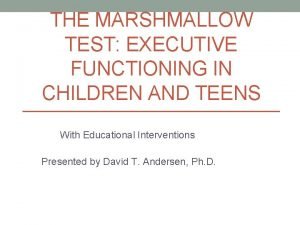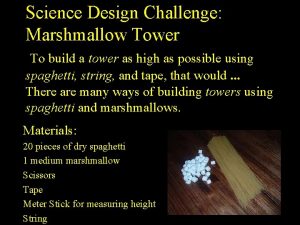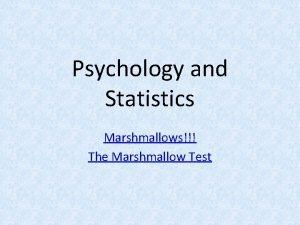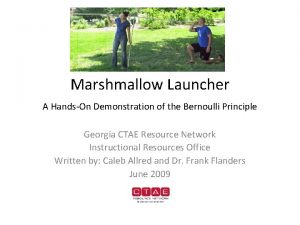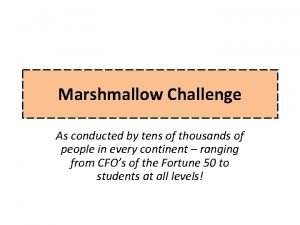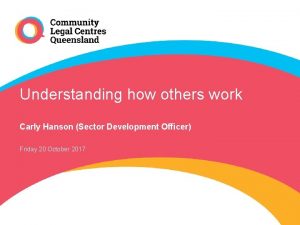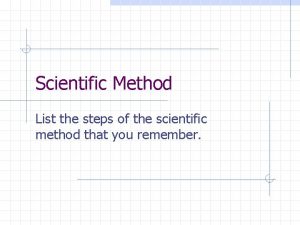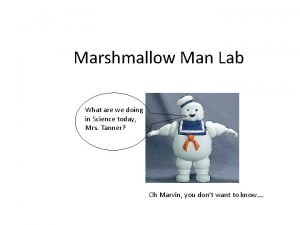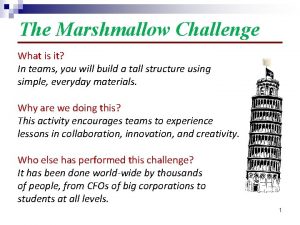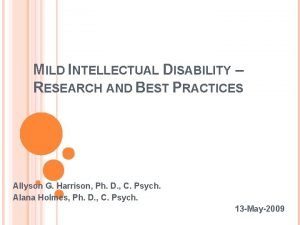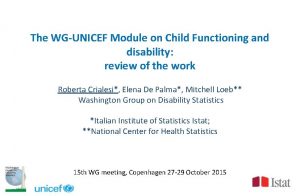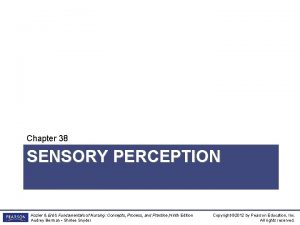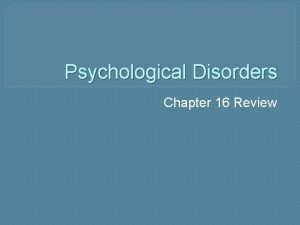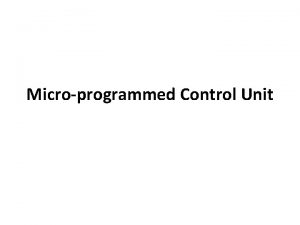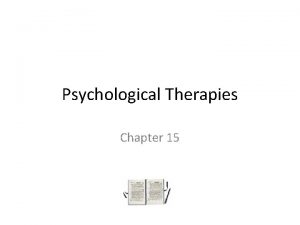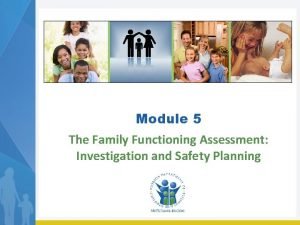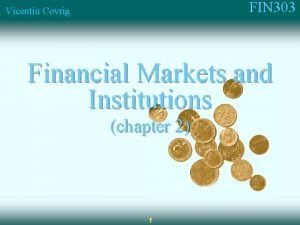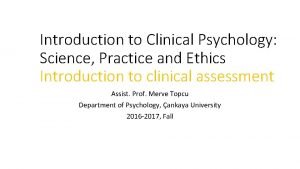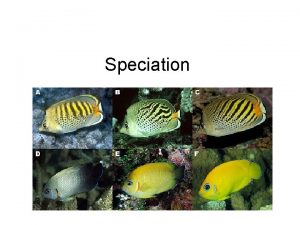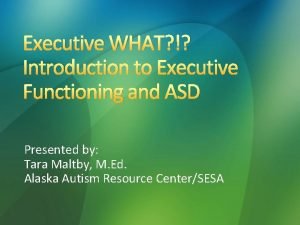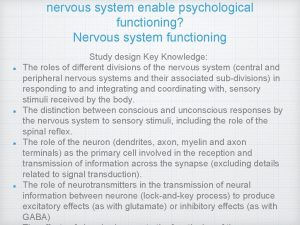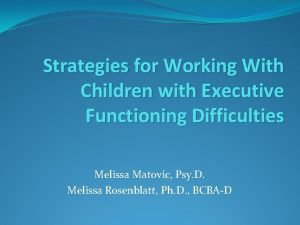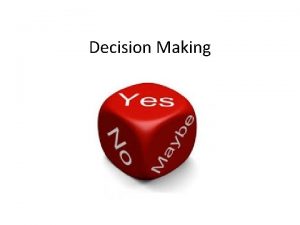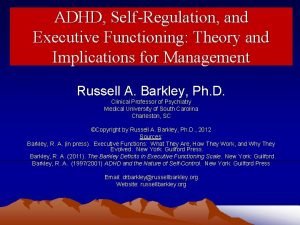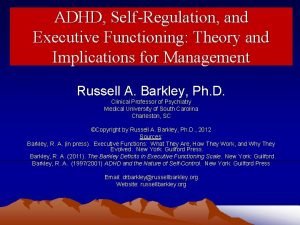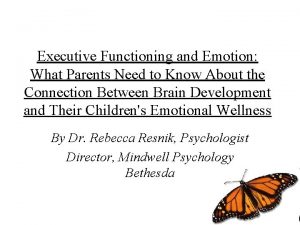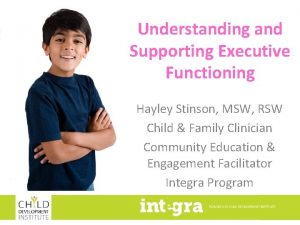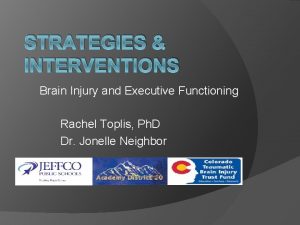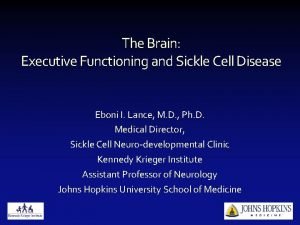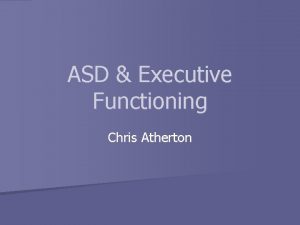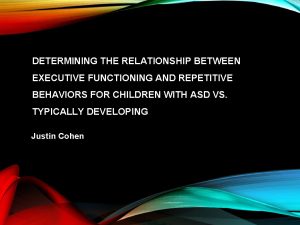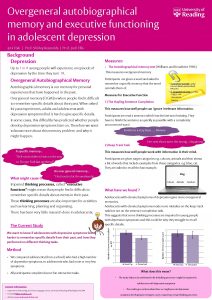THE MARSHMALLOW TEST EXECUTIVE FUNCTIONING IN CHILDREN AND














































- Slides: 46

THE MARSHMALLOW TEST: EXECUTIVE FUNCTIONING IN CHILDREN AND TEENS With Educational Interventions Presented by David T. Andersen, Ph. D.

Topics for Today: Part One • Definition of Executive Functioning (EF). • Looking at the neurological basis for EF. • The Marshmallow test: emotional control and behavioral inhibition. • The importance of neuroplasticity and mirror neurons in the development of EF skills, especially the skills of inhibition and emotional control.

Topics for Today: Part Two • Attention and executive functioning. • The influence of working memory and the capacity to self monitor on reading comprehension. • Teaching EF skills.

Executive Functioning: Definition • Executive Functioning Skills are a set of eight inter-related cognitive operations, mediated by the frontal lobes, that are responsible for goal directed, problem solving behavior.

EF Defined • These cognitive operations consist of the capacity to inhibit or resist an impulse (Inhibit), to shift freely from one activity or mental set to another (Shift), and to regulate emotional responses (Emotional Control). In addition, executive functioning includes the capacity to initiate or begin a task or activity (Initiate), to hold information in mind for the purpose of completing a task (Working Memory), to manage current and future oriented task demands (Plan/Organize), to keep track of one’s possessions (Organization of Materials), and to monitor one’s own performance or to pay attention to the effect of one’s behavior on others (Monitor).

An additional EF definition • Steven Feifer, a prominent school neuropsychologist, suggests that executive functioning can also be thought of as a set of multiple cognitive processes that act in a coordinated way to direct cognition, emotion, and motor functions.

Why Focus on Executive Functioning? • The emergence of executive functioning deficits in PPT conversations. EF skills have become a main focus for psychologists, neuroscientists, and educators. Cognitive neuropsychology in general is a hot topic and it seems to be the direction in which school psychology is headed. • As LD classifications seem to diminish, there has been a greater emphasis on EF skill deficits. • Most importantly, EF skills are essential to academic and social success. • The Marshmallow Test: Behavioral inhibition and emotional control

Left Hemisphere: Cerebral Cortex, Cerebellum, and Brain Stem

Frontal Lobes • Evolutionary Perspective: Frontal lobes are the most recent addition to the human brain. • Frontal lobes comprise about 33% of the entire cerebral cortex for humans (about 15% for monkeys, 8% for dogs). • Studies have shown that in mammals, the higher and more complex degree of social living, the more frontal lobe architecture there will be. • The function of the frontal lobes is often compared to the function of an orchestra conductor.

Frontal Lobe and Limbic System

Right Hemisphere

Frontal Lobe and Limbic System 2

Frontal Lobes (Continued) • Developmental Perspective: Last part of the brain to fully mature (between 18 to 20 years of age). This has legal implications in cases of capital crimes. • However, • in terms of neuroplasticity, the brain never ceases to develop.

Neuroplasticity • Refers to the discovery by neuroscientists that the structure and functioning of the brain changes, in children and adults, due to experience. • Experience for the nervous system involves the activation of neural firing in response to a stimulus. When neurons become active, their connections to each other grow and supportive cells proliferate. This is how experience shapes neural structure.

A Neuron Schematic

Neuroplasiticity • Neuroplastic changes not only generate structural alterations, they also are accompanied by changes in brain function, mental experience (feelings and emotional balance), and physical responses to stress. • An important axiom in neuroscience is: • “Cells that fire together, wire together. ” • Indeed, learning can be defined as the associations between neurons that are developed through repeated neural firing.

Neuroplasticity • Neuroplasticity was found through advances in neuro-imaging techniques, the discovery of mirror neurons, and the results from autopsies, hemisphere-ectimies, and strokes.

Neuroplasticity (Continued) • This has significant implications for educators. • Skills that you have not learned, you can learn through repetition, sustained attention and effort in mastering the skill, and having the skill modeled (and scaffolded) by more competent peers and adults (one of Vygotsky’s main ideas).

Neuroplasticity • Mirror neurons are important to neuroplasticity in that they refer to processes within our social brain that perceive the intentional, goal directed actions of others and link this perception to the priming of the motor systems needed to engage in the same action. In other words, what we see, we become ready to do or to feel.

Neuroplasticity, inhibition, and emotional control • Example from the attachment theory and emotional intelligence literature: Young children learn to regulate emotions through empathically based interactions with parents and other caregivers. These interactions set up the neural pathways from the frontal lobes to the amygdala, part of the emotional brain.

Emotional Control: The Marshmallow Test Revisited • The ability to regulate emotions derives in part from early attachment experiences with caregivers where emotions were consistently (not perfectly) recognized, validated, empathized with, and seen as opportunities for intimacy, social relationships, and goal attainment.

Emotional Control • Relational experiences throughout life promote the development of self regulation in the brain, specifically, the pre-frontal regions. This insight – that neural pathways develop in response to interpersonal relationships – has generated the research in the new field of interpersonal neurobiology.

Emotional Control: The Marshmallow Test Revisited • Researchers have found that over time, the interpersonal regulation of affect becomes internalized into self-soothing and the capacity to regulate inner states. • Studies have shown that children born into a family where parents do not respond to the child’s affective experience have deficits in brain functioning as early in life as one year. • The EF skill of emotion regulation in children and teens involves the ability to be aware of, tolerate, put into words, and use emotions adaptively to regulate distress.

Summary: The Importance of Appropriate Emotional Regulation • The awareness and integration of affect that is characteristic of behavioral inhibition and emotional control has been shown to increase creativity and cognitive flexibility while improving decision making and problem solving skills. In other words, appropriate emotional control enhances cognitive performance. It also has been shown to be associated with several important mental health benefits.

Part Two: Executive Functioning Skills and Attention • Executive Functioning Skills refer to a set of inter- related cognitive operations that are responsible for purposeful, goal directed and problem solving behavior. These operations are all mediated by the frontal lobe. • Sustained Attention is a core or foundational skill that is important to several domains of EF. Sustained Attention refers to the ability to direct and maintain a focused attention on a specific stimulus. • Selective Attention refers to the ability to attend selectively to stimuli in the environment.

Executive Functioning Skills and Attention • Sustained Attention and Selective Attention are requirements for basic information processing and they are skills mediated by the right dorso-lateral cortex of the frontal lobe. The function of attention has been compared to the combined effects of a spotlight and a vacuum cleaner and it is the primary way neural structures develop. That is, the brain learns mainly from what the mind attends to.

Executive Functioning, Attention, and ADHD • William James, a well known philosopher and one of the founders of the field of psychology, famously said in the late 1800’s. • “The education of attention would be an education par excellence. ” • ADHD is seen as a frontal lobe dysfunction where the neurons responsible for attention and the inhibition of behavior are “asleep. ” Stimulant medications work because they target and stimulate these neurons.

EF Skills (Continued) • There are two strands of EF: Behavioral Regulation (BR) and Metacognition (MC). • BR: Inhibit, Shift, Emotional Control. • MC: Initiate, Working Memory, Plan/organize, Organization of Materials, and Monitor.

Working Memory, Monitoring and Reading • Of children identified as having specific learning disabilities, the great majority (over 80%) have a disability in the area of reading. • On the WISC-IV, the two test indices that best predict successful readers are the Verbal Comprehension and Working Memory Indices. Verbal Comprehension looks at concept formation (vocabulary), social judgment, and abstract thinking; working memory in reading refers to the capacity to remember the information that comes at the beginning of a sentence or paragraph so that the information that comes later makes sense. Good readers have good working memory.

Monitoring • Good readers also have the metacognitive ability to monitor their performance. This means that a successful reader pays attention to comprehension and quickly becomes aware if the material has not been understood. • In contrast, poor readers will decode large sections of the text before they become aware of comprehension deficits.

Teaching EF Skills • In general, children who have executive functioning issues require structure in their daily lives, clear and simple directions on how to accomplish tasks, clear expectations, and lots of praise when they display even the smallest EF skills. • Remember to create an environment that functions as a surrogate frontal lobe. Examples would include graphic organizers, sticky notes, and nonverbal signals from teacher to student to help the student refocus or to inhibit behavior.

Teaching EF Skills • Stated another way, when teaching executive functioning skills, it is important to create an environment that functions as an executive function. Through repetition, modeling, and engagement with the specific intervention, neural pathways develop in the student that are then used for both behavioral regulation and metacognitive skills.

Teaching EF Skills • Overlearned tasks are less likely to overwhelm a student’s existing capacity for EF skills. For example, learning to drive a stick shift at first takes all of your attention. When shifting becomes automatic, one can simultaneously drive and think about other tasks. • Explicitly demonstrate problem solving strategies that the student will need in class. This helps with the EF skills of initiating and monitoring.

Teaching EF Skills • Reading: requires attention, impulse control, cognitive flexibility, working memory, and self monitoring. Math: requires attention, self monitoring, planning and organizing, working memory, and impulse control. Writing: requires working memory, self monitoring skills, and the capacity to initiate a task or activity, and the integration of information from several brain centers.

Educational Interventions • Educational Interventions need to function as a surrogate frontal lobe (See handout). Repetition is essential. Problem Behaviors Thinking Systems Difficulty Getting Started Executive Function: Initiate slow/unable to begin a new task, activity, or assignment Instructional Strategies • provide written and oral directions; • check that directions are clear; • begin work with mentor; • segment the work into small initial steps; • fold student's paper in halves, quarters, accordion patterns and ask them to work on just the first space

Disorganized - poor time Executive management skills; Function: inability to plan Organization ahead; difficulty with sequencing; messy desk/locker; failure to turn-in work although it is complete; misplaces books/materials; written work appears messy and lacks coherence. • external organizers (calendars, watch with alarm); • instructional chart with sequence of steps articulated; • instruction chart posted on desk top on index cards or stickies; • daily schedule, routines, rituals; • study buddy; • assistive listening devices; • keyboarding instruction and computer;

Distractible - not responding when called upon; poor task completion; difficulty distinguishing important information/ main idea from less important; skipping from one activity to the next. Executive Function: Sustained Attention • preferential seating; • instruction on appropriate academic level; • assignments that are highly engaging; • hands-on learning, based on interests and strength; • reducing the number of items per assignment; • alternating response modes; • permitting students to work problems in an unusual order (bottom to top); • using external non-verbal cues to prompt student to return to task; • increasing the amount of immediate feedback (e. g. , circulate during independent work and correct some of each student's work to provide immediate feedback); • using cooperative learning after the strategies have been taught to whole class;

Hyperactive - difficulty staying in chair; high level of gross-motor activity (younger children); restlessness (adolescents); seeks sensory stimulation (chewing, tapping, leg swinging); Executive Function: Sustained Attention • providing acceptable opportunities for movement rather than attempting to restrict activity; • providing a specific number of walking passes (e. g. , sharpening pencil, drinks of water, access to books, wall charts); • providing small manipulables to channel activity from gross to fine motor (e. g. , clay, stress balls); • establishing work centers as opportunity to move to choice activity; • standing random-drills; • restating rules before the opportunity for rule infraction; • increasing proprioceptive feedback (consult with OT or PT); • instructional strategies that use tactile materials

Impulsive - shouts out answers without being called upon; exhibits risk taking behaviors; does not think about consequences of behavior; difficulty following rules; difficulty taking turns; Executive Function: Inhibition • teaching self-monitoring skills; • teaching self-regulating skills; • teaching the behavior you want to see; • giving positive feedback 5 to 8 times more frequently than negative ones; • teaching student verbal or motor response to use while waiting (e. g. , holding up a "HELP" card, writing note to self so he will remember)

Memory - inconsistent and/ or Executive Function: poor recall of previously Working Memory; learned information; reduced Attention reading comprehension with long and/or complex sentences; forgetting assignments, social commitments. • segment study time into smaller units; structured breaks; alternating subject matter • mute-sensory instruction; • establish lesson context and links to prior knowledge; • highlight most important features (color coding, shapes, size emphasis); • provide opportunity for novel repetitions until student achieves automaticity of basic skills/facts

Self-Monitoring and Evaluation - lacks "internal voice, " the internal dialogue to selfcoach and/or guide thinking and behavior; unaware that his/her behavior is inappropriate, annoying to others; difficulty checking work once completed; Executive Function: Monitoring • role model by thinking out loud; • provide non-judgmental feedback to establish sequence and causality of events; • provide rubric on desktop for correcting work and provide structured practice in using it

Transition - difficulty transitioning between activities, subjects, classes; repeats same idea, question after receiving a response; repeats same error even when told it is incorrect Executive Function: Sustained Attention • provide three-part transition cues (stopping, moving to, and starting); • develop transition rituals; • create transition songs, games, activities (primary grades)

References • Damasio, Antonio (2005) Descartes’ Error: Emotion, Reason, and the Human Brain. New York, NY. Putnam. • Davidson, Richard, & Begley, Sharon (2012). The Emotional Life of Your Brain. , New York, NY. , Hudson St. Press. • Gilgun, J. (2010) Executive Function & Self Regulation in Children. E: books, Smashwords Edition. • Greenberg, Leslie (2010). Emotion Focused Therapy. , Washington, DC. , American Psychological Association. • Kaufman, C. (2010). Executive Function in the Classroom. Baltimore, MD. , Paul H. Brookes Publishing

References • Le. Doux, Joseph (1996). The Emotional Brain. , New York, NY. , Touchstone. • Seifer, S. G. & Toffalo, D. A. , (2007) Integrating RTI with Cognitive Neuropsychology. Middleton MD. , School Psychology Press. • Schore, A. N. (2003). Affect Dysregulation and the Disorders of the Self. New York, NY. , Norton • Siegel, Daniel (2007). The Mindful Brain. New York, NY. , Norton.

Appendix I: Empirically supported functions of the middle prefrontal cortex 1. Body regulation in terms of monitoring the sympathetic 2. 3. 4. 5. 6. 7. 8. and parasympathetic nervous system. Attuned communication with others. Emotional balance. Response flexibility: the capacity to pause before responding. Empathy. Insight. Fear modulation. Morality.

Appendix II: Improving Adult EF • Mindfulness meditation: There are over 1000 peer reviewed journal articles in psychology on the mental health benefits of mindfulness meditation. Mindfulness has been shown to improve cortical functioning in the right dorsal lateral prefrontal cortex and it has been shown to prevent the adverse effects of aging on the capacity for attention. Mindfulness has also been shown to increase left prefrontal lobe and immune system functioning. • Exercise: Increases cognitive abilities and the EF skill of memory. Exercise is associated with neurogenesis in the hippocampus - part of the limbic system that is important to memory. Exercise has also been shown to have several mental health benefits.
 Marshmallow test executive function
Marshmallow test executive function Strongest marshmallow and toothpick tower
Strongest marshmallow and toothpick tower Spaghetti tower ideas
Spaghetti tower ideas Marshmallow challenge statistics
Marshmallow challenge statistics Ode to a marshmallow
Ode to a marshmallow Marshmallow launcher
Marshmallow launcher Marshmallow
Marshmallow Best spaghetti marshmallow structure
Best spaghetti marshmallow structure Hanson wok
Hanson wok In marshmallow muscles what is the independent variable
In marshmallow muscles what is the independent variable Marshmallow man lab
Marshmallow man lab Don't eat the marshmallow yet
Don't eat the marshmallow yet For four people
For four people Marshmallow challenge solution
Marshmallow challenge solution What is child functioning module
What is child functioning module Borderline intellectual functioning
Borderline intellectual functioning Adaptive functioning
Adaptive functioning Borderline intellectual functioning
Borderline intellectual functioning Adaptive functioning
Adaptive functioning High functioning autism symptoms
High functioning autism symptoms What is child functioning module
What is child functioning module Sensory functioning fundamentals of nursing
Sensory functioning fundamentals of nursing Process of striving toward ideal functioning
Process of striving toward ideal functioning Functioning of micro programmed control unit
Functioning of micro programmed control unit Phrasal verb for stop working
Phrasal verb for stop working Autoclave ppt
Autoclave ppt Advantages of group therapy
Advantages of group therapy Six domains of the family functioning assessment
Six domains of the family functioning assessment High functioning autism
High functioning autism Five principles of psychological functioning
Five principles of psychological functioning Well functioning financial markets
Well functioning financial markets Sentence completion test psychology questions
Sentence completion test psychology questions Cat children's apperception test
Cat children's apperception test Risb test slideshare
Risb test slideshare Hình ảnh bộ gõ cơ thể búng tay
Hình ảnh bộ gõ cơ thể búng tay Ng-html
Ng-html Bổ thể
Bổ thể Tỉ lệ cơ thể trẻ em
Tỉ lệ cơ thể trẻ em Gấu đi như thế nào
Gấu đi như thế nào Tư thế worm breton
Tư thế worm breton Hát lên người ơi
Hát lên người ơi Môn thể thao bắt đầu bằng từ chạy
Môn thể thao bắt đầu bằng từ chạy Thế nào là hệ số cao nhất
Thế nào là hệ số cao nhất Các châu lục và đại dương trên thế giới
Các châu lục và đại dương trên thế giới Công thức tiính động năng
Công thức tiính động năng Trời xanh đây là của chúng ta thể thơ
Trời xanh đây là của chúng ta thể thơ Mật thư tọa độ 5x5
Mật thư tọa độ 5x5
